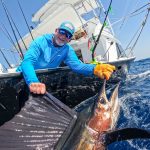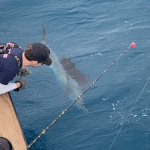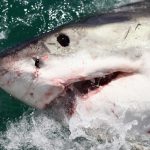

NASA Data Shows Florence Brings Torrential Rains and Record Flooding to the Carolinas Originally posted: September 17, 2018 | Article courtesy: blogs.nasa.gov NASA estimated the precipitation generated by Hurricane Florence from Sept. 10 through 17 as it approached North Carolina and days after it made landfall. On Sept. 17, Florence’s remnant rainfall was moving up the Appalachian Mountains into the Mid-Atlantic.
Florence’s History
After making its way across the Atlantic, Florence, a once powerful Category 4 hurricane with maximum sustained winds reported at 140 mph by the National Hurricane Center (NHC), finally made landfall early Friday morning at around 7:15 a.m. EDT September 14th near Wrightsville Beach on the coast of North Carolina just east of Wilmington.
Although its maximum sustained winds had decreased to 90 mph when it made landfall, making it a Category 1 storm, Florence was still a very dangerous storm with a peak wind gust of 105 mph recorded at Wilmington, No. Carolina. By this time, Florence was a large storm with a large wind field.
Having undergone an eyewall replacement cycle on Sept. 11, wherein a new eyewall forms and replaces the original inner eyewall, Florence traded some of its peak intensity for size before reaching the coast. This kept the storm surge threat high even though the peak winds were down. New Bern, No. Carolina was hit by a reported 10 foot storm surge, which stranded many residents. In addition to its large size, Florence also slowed down as it approached the coast, allowing a good portion of its circulation to remain over water as it slowly made its way inland. This set the stage for a major flooding event over the Carolinas and was well forecast by NHC.
 Above: NASA’s IMERG estimated Florence’s rainfall from Sept. 10 to 17, 2018. IMERG estimates show on the order of 250 mm of rain (~10 inches, shown in red) or more reaching inland over most of central and southern No. Carolina as well as the northeast corner of So. Carolina. However, along the southeast coast of North Carolina between Cape Fear and Cape Lookout rainfall amounts are much higher, IMERG estimates are on the order of 500 mm (~20 inches, shown in purple) or more. Locally, upwards of 30 inches of rain were reported in parts of North Carolina with reports of over 35 and 33 inches in Elizabethtown and Swansboro, respectively. Credit: NASA/JAXA, Hal Pierce
Please click HERE to read article on our website now!
Above: NASA’s IMERG estimated Florence’s rainfall from Sept. 10 to 17, 2018. IMERG estimates show on the order of 250 mm of rain (~10 inches, shown in red) or more reaching inland over most of central and southern No. Carolina as well as the northeast corner of So. Carolina. However, along the southeast coast of North Carolina between Cape Fear and Cape Lookout rainfall amounts are much higher, IMERG estimates are on the order of 500 mm (~20 inches, shown in purple) or more. Locally, upwards of 30 inches of rain were reported in parts of North Carolina with reports of over 35 and 33 inches in Elizabethtown and Swansboro, respectively. Credit: NASA/JAXA, Hal Pierce
Please click HERE to read article on our website now!
IMERG Video of Rainfall Over the Carolina’s After Florence Landfall
 Above: NASA’s IMERG estimated Florence’s rainfall from Sept. 10 to 17, 2018. IMERG estimates show on the order of 250 mm of rain (~10 inches, shown in red) or more reaching inland over most of central and southern No. Carolina as well as the northeast corner of So. Carolina. However, along the southeast coast of North Carolina between Cape Fear and Cape Lookout rainfall amounts are much higher, IMERG estimates are on the order of 500 mm (~20 inches, shown in purple) or more. Locally, upwards of 30 inches of rain were reported in parts of North Carolina with reports of over 35 and 33 inches in Elizabethtown and Swansboro, respectively. Image: NASA/JAXA, Hal Pierce Video Courtesy: NASA Video | YouTube
Please click HERE to watch video on our website now!
Split Frame of Hurricane Florence’s Record Setting Rainfall
Above: NASA’s IMERG estimated Florence’s rainfall from Sept. 10 to 17, 2018. IMERG estimates show on the order of 250 mm of rain (~10 inches, shown in red) or more reaching inland over most of central and southern No. Carolina as well as the northeast corner of So. Carolina. However, along the southeast coast of North Carolina between Cape Fear and Cape Lookout rainfall amounts are much higher, IMERG estimates are on the order of 500 mm (~20 inches, shown in purple) or more. Locally, upwards of 30 inches of rain were reported in parts of North Carolina with reports of over 35 and 33 inches in Elizabethtown and Swansboro, respectively. Image: NASA/JAXA, Hal Pierce Video Courtesy: NASA Video | YouTube
Please click HERE to watch video on our website now!
Split Frame of Hurricane Florence’s Record Setting Rainfall
 Above: For days, Hurricane Florence’s relentless bands of heavy rain fell on North Carolina, as shown in these satellite-based estimates of precipitation from NASA’s IMERG algorithm. The left side of the screen shows the storm-total rainfall rising, starting on Thursday, September 13, at 9AM EDT. The right side of the screen tracks the storm using a 3-hour-average rain rate throughout the duration of the storm. Hurricane Florence’s abrupt slowdown near landfall in North Carolina is easily discernable in the 3-hour rain rate. NASA Goddard generates these realtime estimates by calibrating, merging, and morphing data from the international constellation of rain-observing satellites in Earth orbit. Credit: NASA Video Courtesy: NASA Video | YouTube
Please click HERE to watch video on our website now!
Above: For days, Hurricane Florence’s relentless bands of heavy rain fell on North Carolina, as shown in these satellite-based estimates of precipitation from NASA’s IMERG algorithm. The left side of the screen shows the storm-total rainfall rising, starting on Thursday, September 13, at 9AM EDT. The right side of the screen tracks the storm using a 3-hour-average rain rate throughout the duration of the storm. Hurricane Florence’s abrupt slowdown near landfall in North Carolina is easily discernable in the 3-hour rain rate. NASA Goddard generates these realtime estimates by calibrating, merging, and morphing data from the international constellation of rain-observing satellites in Earth orbit. Credit: NASA Video Courtesy: NASA Video | YouTube
Please click HERE to watch video on our website now!
Dock Etiquette: Acting Right Around Boats Article by: Elliott Stark | Originally posted June 2018 InTheBite
“You know, that’s something that’s really, really important. Sometimes, it just doesn’t cross people’s minds,” says Capt. Jimmy Waller of Orange Beach, Alabama. Waller, whose nickname is “PeeWee” runs his 60’ Big Adventure. The topic of fishing etiquette touched off something special for Capt. Jimmy. “We have been cobia fishing, spotted a fish and had people on jet skis pull up to the boat and ask us what we are doing. One time it happened in a tournament. We were working a fish and had a guy and a girl come up to us on a jet ski. They pulled up to us and said, ‘Ahoy!’ You can’t make this stuff up. This will be my 36th year in the charter business. I’ve seen everything from pornos being made in the salon to just about whatever you can imagine.”
While it may sound pretty evident that making a porno on someone else’s boat crosses a line, the topic of fishing etiquette and how to behave on and around boats can be complicated subject. Those who get it right will enjoy return invitations or repeated free lance stints, those who don’t understand might wind up wade fishing. To determine the expectations of behavior aboard boats, we have surveyed experts from across the sportfishing landscape.
Social Media and Winning with Class
Captains Jeff Shoults and Johnny Dorland have decades of experience tournament fishing in the Gulf. Shoults and his Destin, Florida-based crew on the Mollie won the 2017 Gulf Coast Triple Crown. Dorland is the owner and captain of the Cotton Patch and the director of the Orange Beach Billfish Classic. When asked of the rudest or strangest behavior aboard his boat, Dorland’s two examples were clear. “I had a Tampax put down the toilet once… that wasn’t good. One time we had a guy get completely naked and jump off the tower. We were trolling for marlin 100-miles offshore. He had an inoperable brain tumor… and still does. That was 15-years ago and he’s still not right,” Johnny says with a laugh.
 Please click HERE to read article on our website now!
Please click HERE to read article on our website now!
Fishing for a Cause – Team FFMD and Their Amazing Mission Originally published: September 5, 2018 | Article Courtesy: http://www.fishingformd.com/
The 43-foot Everglades® center console, powered by quad Yamaha F350 outboards, cruised out of Snake Creek, the cut between the Atlantic and Florida Bay at the south end of Islamorada, and headed into a breeze that would continue to pick up throughout the day. Aboard were members of Team FFMD (Fishing for Muscular Dystrophy), with owner and team captain Paul Robertson at the helm. They were competing in the final day of the Jimmy Johnson Quest for the Ring Series dubbed the National Billfish Championship, a major tournament in South Florida’s winter-long sailfish season, and considered by many to be the most prestigious.
The team cruised to an area where fishing had been good the day before, and waited for the tournament committee to give the word over the VHF radio channel assigned to the event. At eight o’clock sharp, the radio crackled with the words, “LINES IN!” and the team went to work.
They deployed two kites, one from each side of the boat. Each would support three lines set in release clips at varying distances from the boat. The lines suspended live baitfish rigged on circle hooks so the bait could dance on the surface, splashing enticingly in an effort to attract the attention of passing sailfish. The morning proved slow, but a move further north towards Key Largo changed the teams luck as two sailfish piled on the baits for a double hookup.
The Everglades® proved the perfect boat for anglers to follow the fish as they moved off in different directions. Paul maneuvered it using the big Yamaha V8s to keep pace. That double release and a single later in the day put the team in a respectable position by tournament’s end, but unfortunately they did not place in the money. They finished 10th in the center console division and 31st overall out of the 99 boats in the tournament, a field comprised of many of the top professional sailfish teams from around the South Atlantic and Gulf states. The upstart team from Maryland did indeed have a good showing under difficult conditions, and it was obvious they made a lot of new friends along the way.
 Above: Team FFMD at 2018 Final Sail Tournament in Key West, FL. Image courtesy: Bluewater Movements // Endlessimagery.com
Please click HERE to read more on Team FFMD on our website now!
Please click HERE to view recent 2018 photos on our website now!
Please click HERE to view our recently updated 2018 Winners List on our website now!
Backlash? Feedback?
Above: Team FFMD at 2018 Final Sail Tournament in Key West, FL. Image courtesy: Bluewater Movements // Endlessimagery.com
Please click HERE to read more on Team FFMD on our website now!
Please click HERE to view recent 2018 photos on our website now!
Please click HERE to view our recently updated 2018 Winners List on our website now!
Backlash? Feedback?

As always, please send comments & feedback on Fishy Times newsletter content directly to us at feedback@roffs.com. If you do not want to wait for our next Fishy Times newsletter, please visit us in the meantime to get all your fishing news using the social media/web links below. Safe and successful fishing until next time!
]]>




